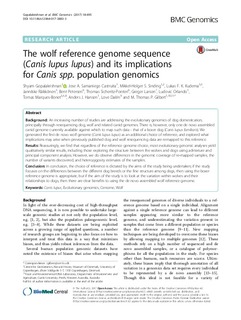| dc.contributor.author | Gopalakrishnan, Shyam | |
| dc.contributor.author | Samaniego Castruita, José Alfredo | |
| dc.contributor.author | Sinding, Mikkel Holger Strander | |
| dc.contributor.author | Kuderna, Lukas FK | |
| dc.contributor.author | Räikkönen, Jannikke | |
| dc.contributor.author | Petersen, Bent | |
| dc.contributor.author | Sicheritz-Ponten, Thomas | |
| dc.contributor.author | Larson, Greger | |
| dc.contributor.author | Orlando, Ludovic | |
| dc.contributor.author | Marques-Bonet, Tomas | |
| dc.contributor.author | Hansen, Anders J. | |
| dc.contributor.author | Dalén, Love | |
| dc.contributor.author | Gilbert, Marcus Thomas Pius | |
| dc.date.accessioned | 2018-06-28T08:19:19Z | |
| dc.date.available | 2018-06-28T08:19:19Z | |
| dc.date.created | 2017-10-24T13:17:47Z | |
| dc.date.issued | 2017 | |
| dc.identifier.citation | BMC Genomics. 2017, 18. | nb_NO |
| dc.identifier.issn | 1471-2164 | |
| dc.identifier.uri | http://hdl.handle.net/11250/2503478 | |
| dc.description.abstract | Background: An increasing number of studies are addressing the evolutionary genomics of dog domestication, principally through resequencing dog, wolf and related canid genomes. There is, however, only one de novo assembled canid genome currently available against which to map such data - that of a boxer dog (Canis lupus familiaris). We generated the first de novo wolf genome (Canis lupus lupus) as an additional choice of reference, and explored what implications may arise when previously published dog and wolf resequencing data are remapped to this reference. Results: Reassuringly, we find that regardless of the reference genome choice, most evolutionary genomic analyses yield qualitatively similar results, including those exploring the structure between the wolves and dogs using admixture and principal component analysis. However, we do observe differences in the genomic coverage of re-mapped samples, the number of variants discovered, and heterozygosity estimates of the samples. Conclusion: In conclusion, the choice of reference is dictated by the aims of the study being undertaken; if the study focuses on the differences between the different dog breeds or the fine structure among dogs, then using the boxer reference genome is appropriate, but if the aim of the study is to look at the variation within wolves and their relationships to dogs, then there are clear benefits to using the de novo assembled wolf reference genome. | nb_NO |
| dc.language.iso | eng | nb_NO |
| dc.publisher | Springer Nature/ BioMed Central | nb_NO |
| dc.rights | Navngivelse 4.0 Internasjonal | * |
| dc.rights.uri | http://creativecommons.org/licenses/by/4.0/deed.no | * |
| dc.title | The wolf reference genome sequence (Canis lupus lupus) and its implications for Canis spp. population genomics | nb_NO |
| dc.type | Journal article | nb_NO |
| dc.type | Peer reviewed | nb_NO |
| dc.description.version | publishedVersion | nb_NO |
| dc.source.pagenumber | 11 | nb_NO |
| dc.source.volume | 18 | nb_NO |
| dc.source.journal | BMC Genomics | nb_NO |
| dc.identifier.doi | 10.1186/s12864-017-3883-3 | |
| dc.identifier.cristin | 1507234 | |
| dc.description.localcode | © The Author(s). 2017 Open Access This article is distributed under the terms of the Creative Commons Attribution 4.0 International License (http://creativecommons.org/licenses/by/4.0/), which permits unrestricted use, distribution, and reproduction in any medium, provided you give appropriate credit to the original author(s) and the source, provide a link to the Creative Commons license, and indicate if changes were made. The Creative Commons Public Domain Dedication waiver (http://creativecommons.org/publicdomain/zero/1.0/) applies to the data made available in this article, unless otherwise stated. | nb_NO |
| cristin.unitcode | 194,31,10,0 | |
| cristin.unitname | Institutt for naturhistorie | |
| cristin.ispublished | true | |
| cristin.fulltext | original | |
| cristin.qualitycode | 1 | |

